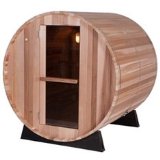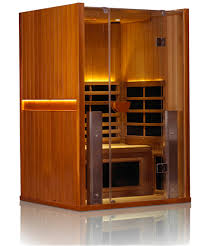2-Person Saunas - A Complete Guide
If you’re thinking about adding a sauna to your home, a 2-person model lives in the sweet spot. Big enough to share, small enough to fit in most homes, and versatile enough for different styles of sauna bathing—it’s no wonder they’re one of the most popular sizes today.
A 2-person sauna gives you flexibility. You can enjoy it with your partner, a friend, or—let’s be honest—hog it all to yourself for some serious stretching room. It’s more energy-efficient than larger models, it doesn’t demand an entire dedicated room or building, and it still delivers the same sauna experience as the big guys.
Let’s walk through the types of 2-person saunas, the features you’ll want to pay attention to, the pros and cons of indoor versus outdoor setups, and where you can actually find the best ones without wasting hours sifting through endless product listings.
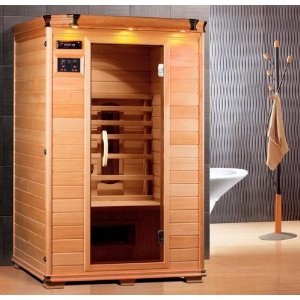
Types of 2 Person Saunas
There are essentially three types of 2 person saunas: traditional, infrared and hybrid. Here is some info on each one.
Traditional (Finnish) Saunas
These heat the air using either an electric heater, gas heater or a wood-burning stove.
- Typical Heat Range: 150–195°F (65–90°C)
- Humidity: Naturally dry, but you can toss water on the rocks for a steam boost.
- Vibe: The “real deal” sauna feel—hot, intense, and great for a deep sweat.
- Best For: People who want that authentic, high-heat, sometimes-steamy experience.
Infrared Saunas
Instead of heating the air first, infrared panels warm you directly.
- Typical Heat Range: 110–150°F (43–65°C)
- Humidity: None—just dry, comfortable warmth.
- Vibe: Gentler on the body, but still makes you sweat. Often preferred for longer sessions.
- Best For: Anyone who wants lower temps and faster warm-up times.
Hybrid Saunas
You get both infrared panels and a traditional heater in the same unit.
- Best For: Couples or families who can’t agree on one style, or people who want total flexibility.
Learn about 1 person saunas here
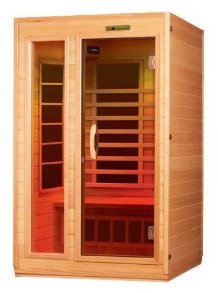
Key Features to Look For
When you’re comparing 2-person saunas, it’s easy to get distracted by flashy extras. But a few things really separate the great saunas from the “meh” ones:
- Size & Layout – Even in the same “2-person” category, layouts vary. Some have two benches side-by-side; others angle them to save space. Look at both the outside footprint and the inside seating arrangement.
- Wood Quality – Canadian Hemlock and Western Red Cedar are the gold standards. Cedar has that rich aroma and resists moisture well; Hemlock is smooth, light-colored, and hypoallergenic.
- Heating Performance – For infrared, check the heater placement. You want full-body coverage (back, sides, legs). For traditional, look at the heater’s wattage and rock capacity—more rocks means more thermal mass and better steam bursts.
- Controls – Inside and outside control panels are a game changer. You can set your temperature and timer without stepping out mid-session. Some come with apps as well so you can turn them on and off remotely.
- Door & Window Style – Tempered glass looks modern and opens up the space visually, but more glass means slightly more heat loss. Solid wood keeps it hotter.
- Lighting – LED lighting is standard, but chromotherapy lights (color therapy) add ambiance. Some people swear by them for mood enhancement and other benefits.
- Audio & Connectivity – WiFi touch screens, Bluetooth speakers, radios, or AUX inputs let you listen to watch programs, listen to music or podcasts while you relax.
- Ease of Assembly – Most home saunas come in pre-fab panels that click together. Some take under an hour, others an afternoon. Check reviews for real-world assembly times.
- Warranty – Quality manufacturers often back the wood and heaters separately. A solid warranty is a sign they expect the sauna to last.
Indoor or Outdoor 2 Person Sauna?
You may be deciding between indoor and outdoor 2 person saunas. Let's look at the pros and cons of each.
Indoor Saunas
- Pros: Easy year-round access, no weatherproofing worries, and they usually require less power. You can place them in a spare room, basement, home gym, or even a large bathroom.
- Cons: You’ll need to manage ventilation to avoid humidity issues (especially for traditional saunas), and you’ll be limited by your indoor space.
Outdoor Saunas
- Pros: Feels like a mini retreat—especially in winter when you step outside into the cold air post-sauna. They’re often more visually striking, with barrel or cabin designs.
- Cons: More expensive, require weather-resistant materials, and sometimes a beefier heater to cope with cooler outdoor temps. You’ll also need to think about site prep—like a flat, stable surface and possibly electrical trenching.
Where to Find the Best 2 Person Saunas
Here’s a breakdown by budget so you can zero in on the right range for you:
Budget-Friendly ($1,200–$2,000)
- Amazon – Good selection of infrared models from brands like Dynamic, Maxxus, and Radiant. They won’t have the lifespan of high-end units, but they’re affordable and get the job done for casual use.
Mid-Range ($2,000–$3,500)
High-End ($4,500+)
- Sunlighten – Premium infrared saunas with medical-grade heaters, sleek designs, and advanced wellness features like red light therapy add-ons.
- Heavenly Heat – Specializes in low-EMF, low-toxin saunas with excellent build quality for those concerned about chemical sensitivity.
- Clearlight – Another luxury infrared option with ultra-low EMF ratings, beautiful cedar or mahogany construction, and top-notch comfort features.
Need a 2 Person Sauna Recommendation?
Need a recommendation?
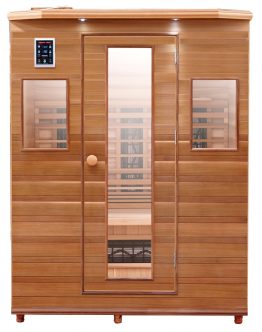
Let our experts help you choose the perfect sauna!
Infrared Saunas
Sauna Heaters
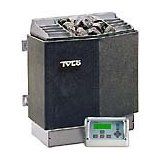
How to Install a Wood Sauna Heater
Sauna Kits
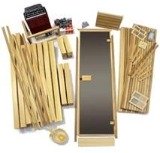
Buying Guide
